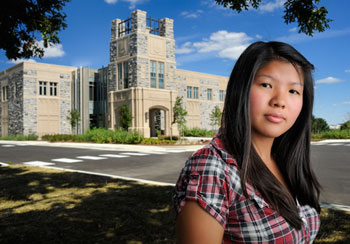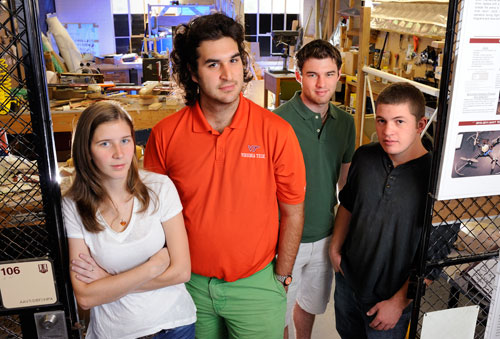 |
|
||||||
|
|
||||||||||||||||||||||||||||||||||||||||||||||||||||||||||||||||||||||||||||||||||||||||||||||||||||||||||||||||||||||||||||||||||||||||||||||||||||
|
Billion-dollar campaign to shape university for years to come By some measures, The Campaign for Virginia Tech: Invent the Future is over. The university officially closed the books on the $1 billion initiative on June 30. But in terms of impact, the effects of this eight-year fundraising campaign are only starting to be realized.For example, on July 5—just days after the university had stopped tallying donations toward a total it will formally announce Nov. 12—Virginia Tech opened a new Visitor and Undergraduate Admissions Center partly financed with donations made during the campaign. Four weeks after campaign-counting stopped, multiple students from Chesapeake, Va., were notified that they would get scholarships of more than $5,000 apiece for their senior year at Tech, thanks to a $1.29 million fund endowed during the campaign. Over the coming months, years, and even decades, many more such examples will arise to demonstrate how the recently ended campaign is still helping Virginia Tech and those it serves.Rae Goldsmith, vice president of advancement resources for the Council for Advancement and Support of Education, an international association of educational institutions, said campaigns have an important long-term impact on institutions. "Campaigns help build your long-term donor base, and that's going to serve any institution well for many years," Goldsmith said. "Many donors make bequests or give in some other way that defers gifts to a future point. And many gifts are endowed."Money from endowed gifts is invested. Because endowment earnings are spent and principal remains untouched, these gifts continue to provide funds, year in, year out, with no end date. Endowments ensure the future During the campaign, donors created 826 new endowments at Virginia Tech. Of those, 563 were arranged to fund scholarships. One such endowment created the Harry Bramhall Gilbert Meritorious Scholarship, which was issued for the first time this year and is expected to help dozens of graduates from the Chesapeake Public School division every year from now on.
Sixty-two new endowment funds from the campaign were crafted to help faculty members. These funds created named professorships or fellowships, set aside resources for specific research, or established faculty awards. Among those endowments was the Blackwood Junior Faculty Fellowship, created in 2006 by Mary (psychology '73) and Willis (business administration '72) Blackwood of Midlothian, Va., and first awarded in 2010 to Assistant Professor of Chemistry Webster Santos. Santos heads a research group seeking to develop drug compounds able to disrupt the progression of diseases such as HIV/AIDS and cancer. He is the first in what will be a long line of faculty members to benefit from this fellowship. "I want to be able to use my organic chemistry knowledge to solve problems in medicine—in reality," Santos said. "At the end of the day, I really want to be able to make a therapeutic drug." In keeping with his goal of creating treatments that are put to use, Santos is helping start Bringing Science to Market, a science-based entrepreneurial program being organized by Virginia Tech's College of Science and Pamplin College of Business. One of the program's first phases will begin this spring, when Santos and Professor of Biological Sciences Joseph Falkinham co-teach a course called Drugs, Germs, and Entrepreneurship. Money from the Blackwood Fellowship has already helped Santos travel to conferences and develop his expertise in the entrepreneurial side of drug development. Endowments are not the only permanent benefits of a campaign. Campaigns help reshape campuses through capital projects, such as new buildings, renovations, or other improvements. Tech's recent campaign was no exception, coinciding with a period of extensive campus construction. Private donations made during the campaign have helped with projects including the Visitor and Undergraduate Admissions Center, the Class of 1958 gates installed at Prices Fork Road and West Campus Drive, and the Center for the Arts under construction at the corner of North Main Street and Alumni Mall. A billion-dollar milestone Announcing a $1 billion campaign goal was a milestone for Virginia Tech, reflecting a new level of ambition for an institution that had raised $337 million in its prior campaign. The announcement also put the university into a fairly exclusive club. Thirty-six U.S. colleges or universities were engaged in campaigns of $1 billion or more as of November 2010, according to the Chronicle of Higher Education. So when the most recent campaign total is disclosed, it will be a historic moment for Virginia Tech. It just won't be the final story on what the campaign means. "Campaigns are less about the dollar goal than they are about what all these donations do to move the institution forward," said Goldsmith. "It's about what good is done for students, for research, for all the things that are important to an institution like Virginia Tech." Albert Raboteau is a writer for University Development. |
|
|||||||||||||||||||||||||||||||||||||||||||||||||||||||||||||||||||||||||||||||||||||||||||||||||||||||||||||||||||||||||||||||||||||||||||||||||||
| - - - - - - - - - - - - - - - - - - - - - - - - - - - - - - - - - - - - - - - - - | ||||||||||||||||||||||||||||||||||||||||||||||||||||||||||||||||||||||||||||||||||||||||||||||||||||||||||||||||||||||||||||||||||||||||||||||||||||
|
With design competitions, young engineers have a foot in the door
Like all seniors majoring in aerospace engineering at Virginia Tech, Victor Zamora will log many hours on a design project this school year. Unlike many of his classmates, the Mount Airy, N.C., native also benefited from similar experiences as a freshman, sophomore, and junior.
Throughout his college career, Zamora has participated on Virginia Tech teams in the Design Build Fly (DBF) competition, tackling a newly unveiled challenge each August. Last year's task was to build an unmanned aerial vehicle that could fit into carry-on luggage and fulfill military demands, such as being able to carry ammunition and medical supplies (simulated with metal bars and golf balls for the contest). In April, Zamora's team placed 19th out of the 82 teams that flew their vehicles in Tucson, Ariz. Virginia Tech's other team finished 45th. Though he didn't get a trophy, Zamora said he learned a great deal from the experience. "It strengthened me as an engineer in the sense that I now have a much greater … skill set, and I also understand the material [from class] in a much more practical way. That is an advantage you can only have by being involved in flying an aircraft." Michael Philen, an assistant professor in the Department of Aerospace and Ocean Engineering and a faculty advisor to the team, also cited the educational benefits of participating.
DBF was one of several engineering teams that provided Virginia Tech students an extracurricular opportunity to put knowledge into practice last year. Like the university's other such teams—including one that won the U.S. Department of Energy's EcoCar competition in June and another that won the international RoboCup robotics competition in July—the DBF team depends on corporate support to compete effectively. Companies that have sponsored the team in recent years include Lockheed Martin, MicroTech, SolidWorks, and Futaba Corp. Supporting design teams like the ones at Virginia Tech is a way for companies to help prepare a future generation of workers. The partnerships also give companies an inside recruiting track. William Mason, an emeritus professor who advised the university's DBF team for many years, said members have gone on to work for some of the industry's leading companies. And some have stayed involved in the contest as judges, "which makes them good contacts for [finding] a job," he said. By bridging the gap between the classroom and the field, such contests not only put theory into practice, but also create a vital connection between young engineers and companies in search of budding talent. Albert Raboteau is a writer for University Development. |
|
|||||||||||||||||||||||||||||||||||||||||||||||||||||||||||||||||||||||||||||||||||||||||||||||||||||||||||||||||||||||||||||||||||||||||||||||||||
|
|



